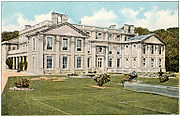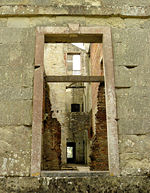
Appuldurcombe House
Encyclopedia

Baroque
The Baroque is a period and the style that used exaggerated motion and clear, easily interpreted detail to produce drama, tension, exuberance, and grandeur in sculpture, painting, literature, dance, and music...
country house
English country house
The English country house is a large house or mansion in the English countryside. Such houses were often owned by individuals who also owned a London house. This allowed to them to spend time in the country and in the city—hence, for these people, the term distinguished between town and country...
of the Worsley
Worsley Baronets
The Worsley family is an English family that is derived from Sir Elias de Workesley, a Norman knight who was a youth at the time of the Norman conquest...
family. The house is situated near to Wroxall on the Isle of Wight
Isle of Wight
The Isle of Wight is a county and the largest island of England, located in the English Channel, on average about 2–4 miles off the south coast of the county of Hampshire, separated from the mainland by a strait called the Solent...
.
It is now managed by English Heritage
English Heritage
English Heritage . is an executive non-departmental public body of the British Government sponsored by the Department for Culture, Media and Sport...
and is open to the public. A small part of the large and 1.2 km² estate which once surrounded it is still intact, but other features of the estate are still visible in the surrounding farmland and nearby village
Village
A village is a clustered human settlement or community, larger than a hamlet with the population ranging from a few hundred to a few thousand , Though often located in rural areas, the term urban village is also applied to certain urban neighbourhoods, such as the West Village in Manhattan, New...
of Wroxall, including the entrance to the park, the Freemantle Gate, now used only by farm animals and pedestrians.
History
Appuldurcombe began as a priory in 1100. It became a conventConvent
A convent is either a community of priests, religious brothers, religious sisters, or nuns, or the building used by the community, particularly in the Roman Catholic Church and in the Anglican Communion...
, then the Elizabethan home of the Leigh family. From there, the site came into the ownership of the Worsleys.
The present house was begun in 1702, replacing the large Tudor
Tudor period
The Tudor period usually refers to the period between 1485 and 1603, specifically in relation to the history of England. This coincides with the rule of the Tudor dynasty in England whose first monarch was Henry VII...
mansion bequeathed to Sir Robert Worsley, 3rd Baronet
Sir Robert Worsley, 3rd Baronet
Sir Robert Worsley, 3rd Baronet Worsley was an MP for Newton Isle of Wight.-Family:He was the son of Sir Henry Worsley , the third Baronet, and Bridget, daughter of Sir Henry Wallop. He married, in 1667, Mary Herbert Sir Robert Worsley, 3rd Baronet Worsley (1612–1666, Appuldurcombe) was an MP for...
. The architect
Architect
An architect is a person trained in the planning, design and oversight of the construction of buildings. To practice architecture means to offer or render services in connection with the design and construction of a building, or group of buildings and the space within the site surrounding the...
was John James. Sir Robert never saw the house fully completed. He died on 29 July 1747, in his memory a monument was erected overlooking the house on Stenbury Down
Stenbury Down
Stenbury Down is a chalk down on the Isle of Wight. It is located close to the town of Ventnor, in the southeast of the island, and rises to 226 metres at its highest point, west of Wroxall, Isle of Wight....
.
The house was greatly extended in the 1770s by his great nephew Sir Richard Worsley, 7th Baronet of Appuldurcombe. The newly extended mansion was where Sir Richard brought his new wife, whom he married ‘for love and £80,000’. Capability Brown
Capability Brown
Lancelot Brown , more commonly known as Capability Brown, was an English landscape architect. He is remembered as "the last of the great English eighteenth-century artists to be accorded his due", and "England's greatest gardener". He designed over 170 parks, many of which still endure...
was commissioned in 1779 to design the ornamental grounds at the same time as the extensions. A romantic ruined folly
Folly
In architecture, a folly is a building constructed primarily for decoration, but either suggesting by its appearance some other purpose, or merely so extravagant that it transcends the normal range of garden ornaments or other class of building to which it belongs...
known as "Cooke’s Castle" was built on the hill opposite to improve the view.
During Sir Richard's time the house held a magnificent art collection, and was the setting for Sir Richard's entertaining of some of the most eminent figures of the age.

Charles Anderson-Pelham, 1st Earl of Yarborough
Charles Anderson-Pelham, 1st Earl of Yarborough , styled Hon. Charles Anderson-Pelham from 1794 to 1823, was the founder of the Royal Yacht Squadron...
, the 2nd Baron Yarborough (later first Earl of Yarborough
Earl of Yarborough
Earl of Yarborough is a title in the Peerage of the United Kingdom. It was created in 1837 for Charles Anderson-Pelham, 2nd Baron Yarborough. The Anderson-Pelham family descends from Francis Anderson of Manby, Lincolnshire. He married Mary, daughter of Charles Pelham of Brocklesby, Lincolnshire...
), founder of the Royal Yacht Squadron
Royal Yacht Squadron
The Royal Yacht Squadron is the most prestigious yacht club in the United Kingdom and arguably the world. Its clubhouse is located in Cowes Castle on the Isle of Wight in the United Kingdom...
at Cowes
Cowes
Cowes is an English seaport town and civil parish on the Isle of Wight. Cowes is located on the west bank of the estuary of the River Medina facing the smaller town of East Cowes on the east Bank...
, made few changes to the house, and was quite happy to retain the property as a convenient base for his sailing activities. In 1855 the estate was sold. An unsuccessful business venture ran Appuldurcombe as an hotel, but with its failure, the house was then leased for use as a college for young gentlemen.
The house was inhabited for a few years in the early 20th century by the large community of Benedictine
Benedictine
Benedictine refers to the spirituality and consecrated life in accordance with the Rule of St Benedict, written by Benedict of Nursia in the sixth century for the cenobitic communities he founded in central Italy. The most notable of these is Monte Cassino, the first monastery founded by Benedict...
monks who had been exiled from Solesmes Abbey in France and were shortly to settle at Quarr Abbey
Quarr Abbey
Quarr Abbey is a monastery between the villages of Binstead and Fishbourne on the Isle of Wight in southern England. The name is pronounced as "Kor" . It belongs to the Order of St Benedict. The present imposing brick construction was completed in 1912. A community of about a dozen monks maintains...
on the Isle of Wight. Troops were billeted in the house during both world wars. It was badly damaged in the Second World War, when a Dornier Do 217
Dornier Do 217
The Dornier Do 217 was a bomber used by German Luftwaffe during World War II as a more powerful version of the Dornier Do 17, known as the Fliegender Bleistift . Designed in 1937 and 1938 as a heavy bomber, its design was refined during 1939 and production began in late 1940...
that was engaged in a mine laying mission turned inland and dropped its final mine very close to the house on February 7, 1943 before crashing into St Martin's Down.
Although the house is now mainly a shell, its front section has been re-roofed and glazed, and a small part of the interior recreated. Today, the house has become well known as one of the most haunted places on the island, with frequent tales and claimed sightings of ghosts. These have included a phantom carriage parked outside the front of the house, brown-clad monks, dark shapes seen roaming the grounds, aa babies cry and claims of unseen hands going through pages of the visitor's book.
Tudor Appuldurcombe
The drawing by Sir Robert Worsley dated 1720 is annotated in his hand as follows:
"Appuldurcombe as I found it in 1690 & of which I have not left one stone standing. This place took its name from its situation for in ye old Armoric Language Pul is a Bottom or Ditch or A Pool And Dur is water. ye Armoric Language is ye of ye Brittons in France And agrees much with ye Cornish & was probably ye language of ye old inhabitants of this Island. ye Saxons added Combe which in their language signifies a Bottom. I thought fitt to leave this Memorandum to Posterity & refer them to Lhuyds Dictionary in ye oldest Court Roll I have which was ye 16 year of King Henry ye Sixth I find it entered Appuldurcombe as above & likewise in some of ye old ones since but they often varyed in ye spelling of it not knowing from whence it was derived." Signed "Rob. Worsley, 1720". Also annotated are, from l to r: "Bowling Green, Great Dining Room with library over it this was formerly a tennis court, Staircase, Parlour, Hall, Hall, Chapell, Stables" Published in Worsley, Sir Richard, History of the Isle of Wight, London, 1781, between pp.180/1.
External links
- Appuldurcombe House website

